Listing References on a Resume (Examples and Template)

Listing reference on a resume can be very powerful. Whether your hiring manager or recruiter is in need of references for your application is a moot point. It's great to list them. And it shows you're willing to put support behind your name to validate your work history and experience.
References can act as wonderful validators. Whether hiring managers decide to contact reference is entirely up to them. Though, the act of having references and listing references is usually enough to show your worth.
Learn about how references play a vital role in job applications. And how to list a professional reference on a resume.
Should you include references?
Yes! Including references in a job application is a great idea.
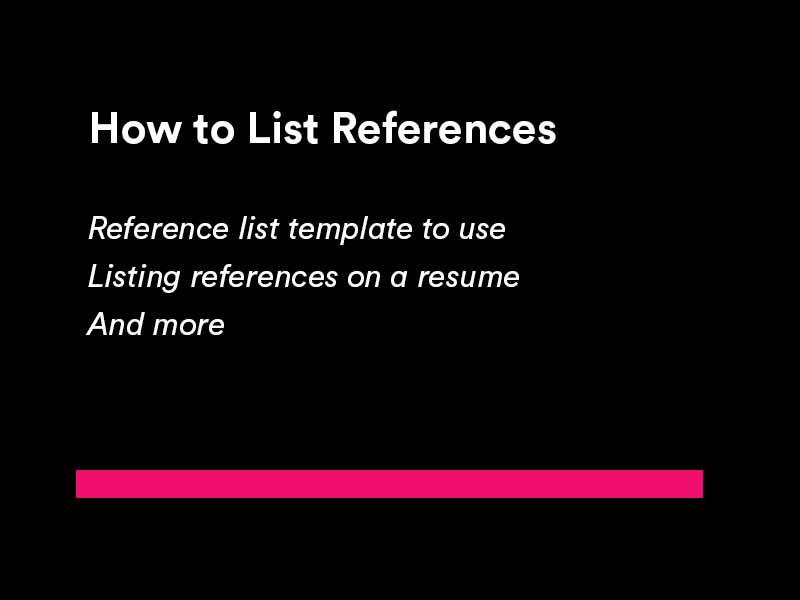
In some cases, a job application portal might not have the field to input references. In which case, you should include your references inside your resume attachment (ideally, a PDF).
Whether the hiring manager asked for references isn't important, include them!
What if you don't want to list references for your job application? You don't have to do that. Unless specifically requested, references are not a requirement to most job applications. And by listing them in advance, you're simply being proactive.
Who should you ask to be a reference
When thinking about people to add as part of your references, it's important to consider who your reference should be.
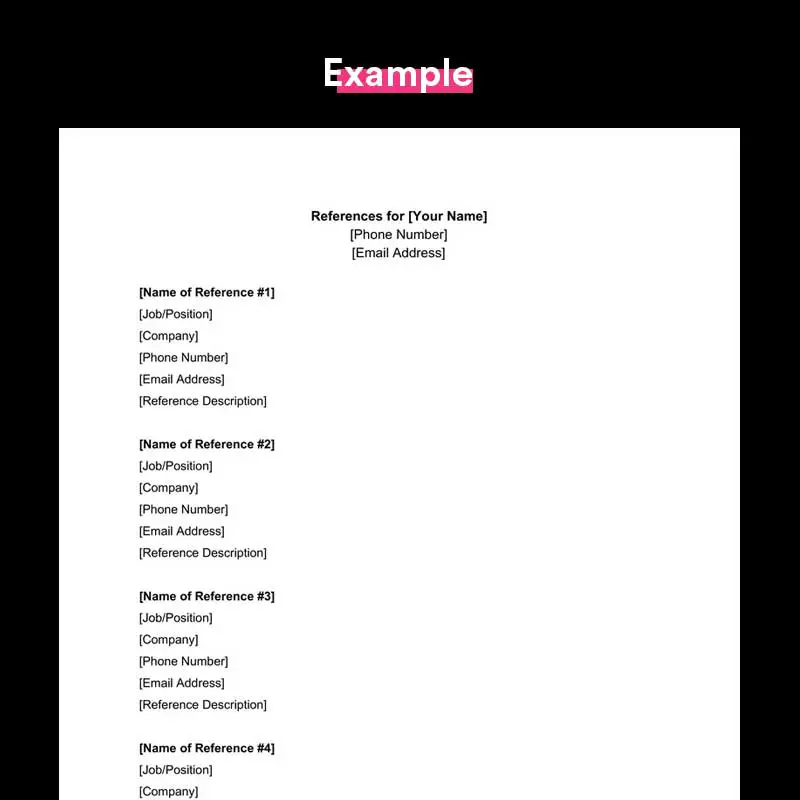
The person you pick should be someone who can speak to the following:
- Your prior job performance.
- Someone who can validate your employment history.
- A professional who can tell stories that speak to your characteristics, competencies, soft skills, technical skills, and hard skills.
Try not to include personal contacts as part of this list.
Personal vs professional references
Personal references are family friends. Or professional family friends. Personal references are more frequently used in real estate/mortgage applications.
Professional references are previous supervisors, employers, and managers.
Always include professional references on your resume. Unless applying for an internship position, where you have no prior work experience.
In that case, it's acceptable to list personal references on your resume.
Who makes the best references:
- A prior direct manager.
- Former colleagues.
- A direct supervisor.
- Most employers.
Try to choose a reference who is going to have the ability to speak to relevant skills that accompany your job hunt. You can determine this by reading the job description/job posting. And scouring through the requirements/responsibilities/duties of the job.
Look for keywords. For example, "requires collaboration with the marketing team."
Learn more about professional references.
Should you put references on a resume?
Should you put the references on the actual resume itself?
No.
Your references should not be a resume section. A resume section is related to your career objective, work history, education, and more.
It's not uncommon for a job seeker to put their references on the resume itself. Don't do this.
Instead, make a new sheet, a reference sheet, and list your references on that sheet.
Most employers won't reach out to references until they are amongst the final candidates for the open position. Meaning, they don't require references in order to submit a job application.
It's a good idea to get ahead of this, though, and include the reference sheet early in the hiring process.
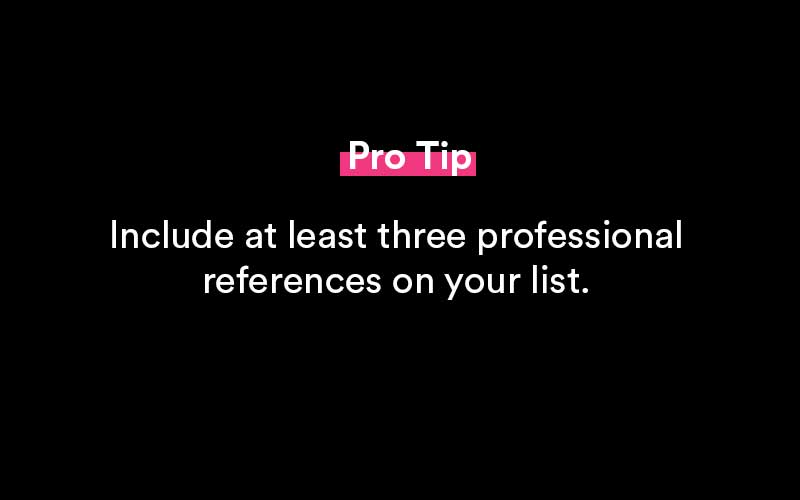
Remember, your resume should only be one-page. Meaning, you want to use this valuable space to list work history and a strong career objective. Rather than contact information for references.
Key takeaway:
It's a best practice to leave references off your resume itself. Make a new sheet that includes your reference list for the hiring manager.
How to list references on a resume
Here's how to list references on your resume. Sometimes referred to as "resume references."
Create a reference list
Scour through the job description. Learn about the company you're applying for. And create a matrix of who you can list on your references that could assist you.
For example, does the company pride itself on innovation? If so, listing a reference who can speak to your capabilities as an executor.
Or if the role is a management position, is there a reference who can speak to your leadership skills?
Decipher who is going to be the best professional contact to list.
Your contact information on the list
Start the reference sheet with your contact information.
This should include the following:
- Your full name.
- Phone number.
- Email address.
- LinkedIn profile (optional).
- Professional website (optional).
The result should look like this (resume reference example):
John Smith
637-884-8376
linkedin.com/j.smith
jsmith.com
Use consistent formatting with the references
Consistent formatting of the references can assist hiring mangers. It makes it easier to comprehend the list. And makes it easier to contact references.
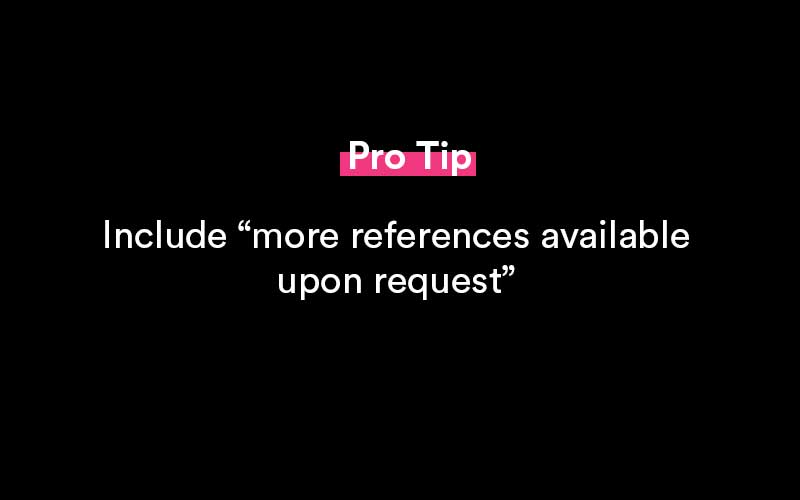
Reminder: The manager isn't going to contact references until they're ready to speak with them. In that circumstance, they could request references from you. Even if you already provided them. If that happens, the manager is ensuring that the list you provided is accurate. And the one you want to use.
Here is how each reference should be formatted:
- [Their full name]
- [Email address]
- [Phone number]
- [Company]
- [Relationship to you]
And the end result should look like the following:
Bryan Brock
633-487-5874
Apple, Inc.
Prior Supervisor
Include at least three professional references
How many references should be on the list? Three!
Three references is the correct amount of references to list.
Attach the references to your resume
Remember, don't put your references on the resume itself. Instead, attach it as a separate sheet/separate page, part of your resume.
Ideally, the employer opens your resume and has two pages of information inside the PDF file. The first page being your resume. The second page being your references.
Keep in mind, this is a proactive move. And references aren't commonly asked for until the final stages of the hiring process.
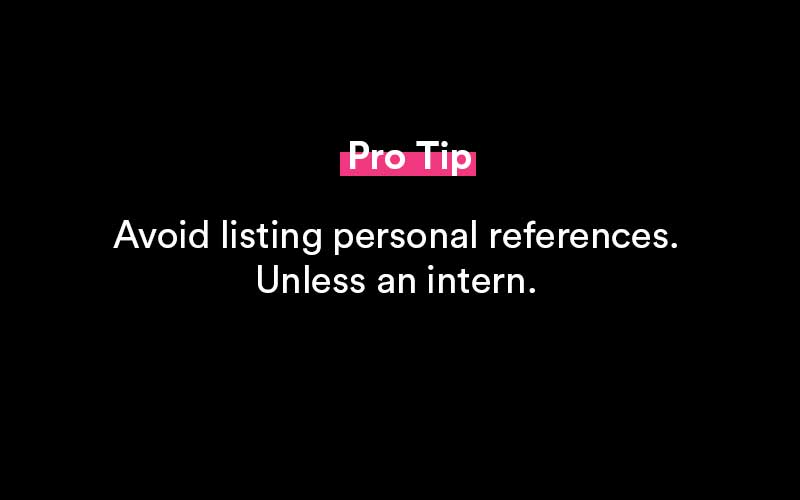
Including "references available upon request" on the sheet
What about "more references available upon request?"
Should this phrase be used on the reference sheet?
Yes, it should!
Why? Having a healthy amount of reference is a good sign to hiring managers.
And if the hiring manager needs to contact more references, to validate other skill sets, its best to inform them that they have that option.
Simply include the following phrase at the bottom of your page:
More professional references available upon request.
How do I ask someone to be a reference?
When starting to look for a new job, building your list of references is going to be a vital part of the job hunt process.
It's best to ask prior employers/supervisors. Those that can write a glowing recommendation based on your work with them at prior jobs.
Another great person to ask would be anyone who you consult regarding career advice. This is a great method for interns and those with no prior work experience.
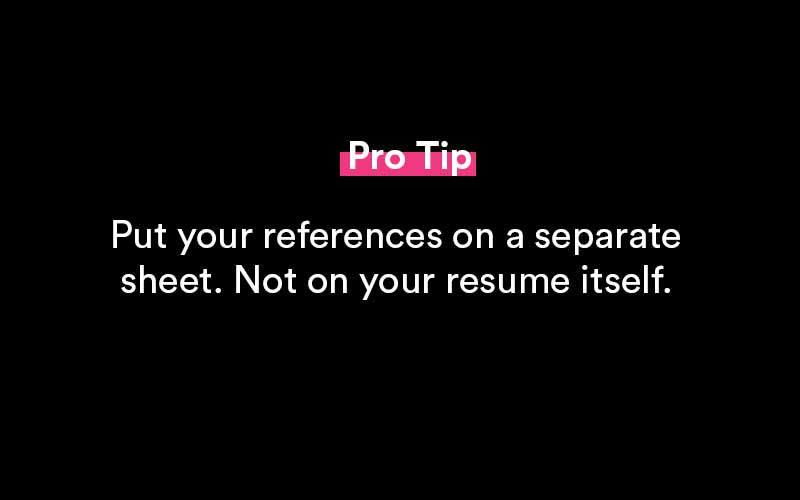
Here's how to ask for a recommendation:
- Determine who you're going to ask.
- Write a short note/email providing the details on the new job you're applying to.
- List the job/companies you're applying for.
- Write a short note on what you need from them. For example, mentioning your interpersonal skills or work ethic.
- Ask if they need any more information.
- Provide the date that you need the recommendation/reference by.
Learn how to ask for a letter of recommendation.
Reference page example
References
-
John Smith
744-857-3867
VP of Product at Apple, Inc.
Former Manager
-
Tyler Tart
630-775-8476
VP of Product at Adobe Inc
Former Manager
-
Sarah Herrington
334-837-2348
Product Manager at XYZ Company
Former Manager
Reference page template
References
—
Reference #1
[Colleague/Manager's Name]
[Colleague/Manager's Email Address]
[Colleague/Manager's Phone Number]
[Job Title @ Company Name]
[Colleague/Manager's Relationship to the Job Applicant]
[Optional: Business Mailing Address]
—
Reference #2
[Colleague/Manager's Name]
[Colleague/Manager's Email Address]
[Colleague/Manager's Phone Number]
[Job Title @ Company Name]
[Colleague/Manager's Relationship to the Job Applicant]
[Optional: Business Mailing Address]
—
Reference #3
[Colleague/Manager's Name]
[Colleague/Manager's Email Address]
[Colleague/Manager's Phone Number]
[Job Title @ Company Name]
[Colleague/Manager's Relationship to the Job Applicant]
[Optional: Business Mailing Address]
Similar resources
- Sales Skills
- Functional Resume
- Interpersonal Skills
- Resume Format
- Volunteer Work on Resume
- How to List References on a Resume
- What is a CV?
- Resume Summary Examples
- Language Proficiency Levels
- Professional Background
- How to Pout Shadowing on a Resume
- Job Hunting
- How Far Back Should a Resume Go
- How to List Publications on Resume
- Skills List for the Resume
Popular Resources

Featured
35+ Phone Interview Questions & Best Sample Answers
Phone interviews have become a core part of the process when attempting to find a secured placement for an open position. Companies receive massive responses from potential candidates for any..

Featured
12+ Best Questions To Ask A Recruiter
Concerning a job search, you might receive numerous offers from your recruiters. Before you choose one, you need to assess all the conditions, for which it is vital that you know everything associated with the offered position..

Featured
Answering "What Makes You Unique" In A Job Interview
Answering this question during a job interview requires more than knowing why you are unique as an individual. Yes, the true scientific answer is made up of two main components: your..

Featured
250+ Ice Breaker Questions for Life
An ice breaker question is a question that’s asked from one person to another person in order to act as a conversation starter. It brings a connection...

Featured
10 Best Answers to "What Motivates You?"
Open-ended questions like “What motivates you?” can elicit a deer-in-the-headlights reaction from job candidates if they are unprepared. It’s a broad question and can leave the interviewer..

Featured
Answering "How Did You Hear About This Position" In An Interview
A lot of interviewers ask this question - how did you hear about this position? This way they can judge you if you are a passive or an active job seeker..

Featured
8 Best Thank You Emails After an Interview (Samples, Free Templates)
Writing a thank you note after an interview says a lot about you as a potential employee. Most notably, it says that you care about the opportunities presented..

Featured
Writing a Resignation Letter (How To Write It, Samples)
Writing the perfect letter of resignation is more of an art than it is a science. And we’re going to cover how to master that art form in this full guide..

Featured
How to End a Letter (Example Salutations, Sign Off's)
Knowing how to end a business note or email is an important skill to develop. It helps portray a sense of confidence, respect and tone to your message..
